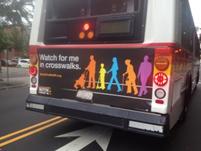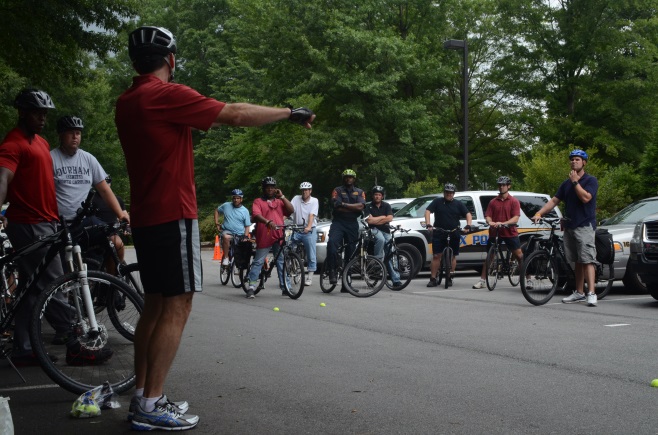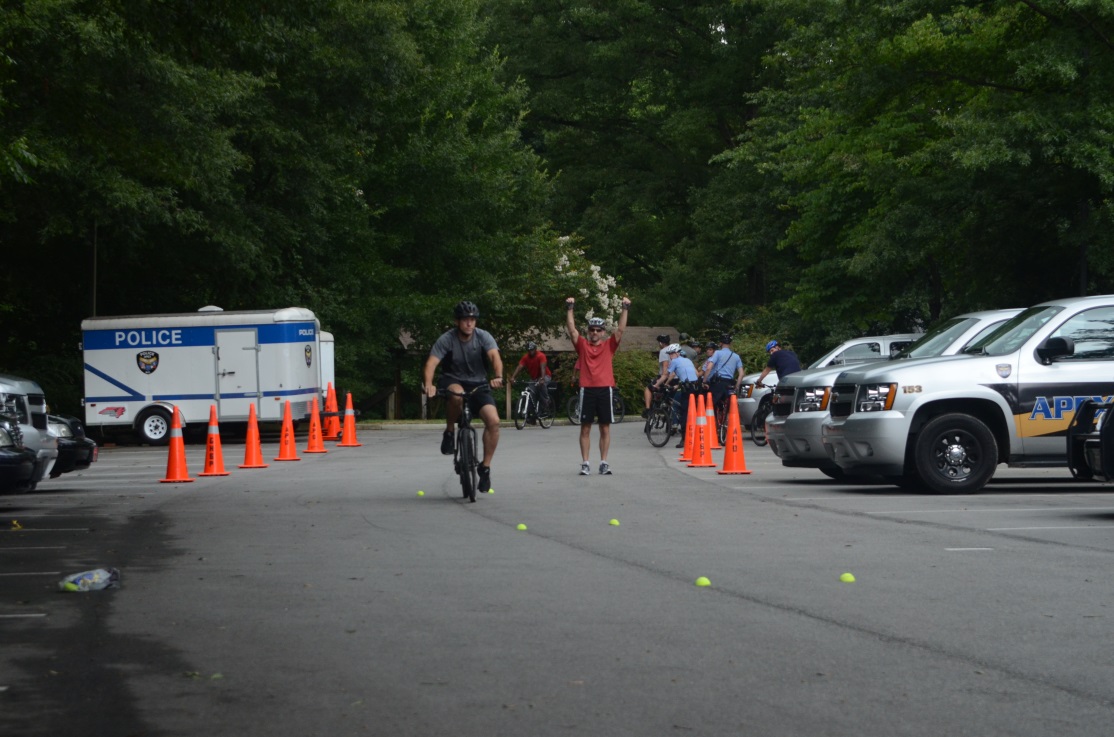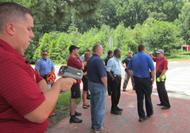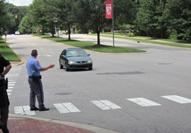Training Law Enforcement Officers to Enforce Pedestrian and Bicycle Laws: Watch for Me NC
Research Triangle Region, North Carolina
Source: Pedestrian and Bicycle Information Center
Background
The Research Triangle, the region of North Carolina anchored by the cities of Raleigh, Durham, and Chapel Hill, is one of the fastest-growing metropolitan areas in the United States. Every year, an average of more than 400 pedestrians and 180 bicyclists are struck by motor vehicles in the Triangle, causing the region to have one of the highest pedestrian crash rates per capita of any major metropolitan area in the country (Transportation for America, 2014). In 2011, a North Carolina Department of Transportation (NCDOT) survey showed that stakeholders were interested in enhancing education and enforcement efforts to increase pedestrian and bicyclist safety throughout the state. At the same time, the National Highway Traffic Safety Administration provided the UNC-Highway Safety Research Center (UNC-HSRC) with funding to develop and evaluate a comprehensive education and enforcement program in partnership with local communities. As a result, UNC-HSRC partnered with NCDOT, local municipalities, county governments, and others to develop a pilot pedestrian and bicycle safety program in the Triangle region.
Countermeasures
To create the pilot program, Watch for Me NC, the team from UNC-HSRC first interviewed local stakeholders and analyzed five years of pedestrian and bicycle crashes to better understand key issues and populations affected. They also considered other community-based enforcement and educational programs that had been implemented in cities in the United States. A steering committeecomprised of UNC-HSRC staff, NCDOT officials, and local agency representativesthen developed a program that combined active and passive outreach efforts with the enforcement of pedestrian and bicycle safety laws. The Watch for Me NC team also reached out to the local media to create broader awareness of pedestrian and bicycle safety, as well as of the possibility of being stopped for violating safety laws. They reinforced their safety messages using advertisements on buses, radio PSAs in English and in Spanish, banners, posters, and through bumper stickers and brochures given out by universities and police officers.
One very important component of Watch for Me NC was a training course designed for law enforcement officers to refresh them about pedestrian and bicycle safety law enforcement. During a series of courses delivered in summer 2012 and 2013, nearly 90 officers participated from 20 North Carolina agencies, including various municipal police departments, sheriff offices, and university public safety officers. The courses included classroom instruction regarding North Carolina laws and best practice for conducting enforcement. Officers also participated in hands-on exercises where they learned about conducting enforcement at intersections and crosswalks and practiced bicycle safety drills. The idea behind the training course was to increase officer knowledge of pedestrian and bicycle safety issues and their capacity for conducting enforcement activities in the future.
Evaluation and Results
A survey given to 43 officers before and after the 2012 trainings, which focused on pedestrian safety, looked at whether officer knowledge of pedestrian safety issues increased and whether officers felt more capable of promoting pedestrian safety through enforcement activities. Following the training course, officers showed a significant increase in knowledge and confidence that they could enforce pedestrian laws. When tested regarding their knowledge of pedestrian laws, correct answers increased from 59 percent before the training course to 85 percent after the training course. There was also a significant increase in the number of officers who agreed with the statements "I am familiar with pedestrian laws," "I can help prevent pedestrian crashes," "I have lots of resources to enforce pedestrian laws," and "I intend to enforce pedestrian laws in the next three months."
Following the pedestrian safety course and the launch of program activities, law enforcement agencies reported pedestrian safety enforcement efforts back to the UNC-HSRC team. From October 2012 to March 2013, six reporting agencies conducted 37 pedestrian safety operations. For five of the six agencies, it was the first time they had ever conducted pedestrian safety activities. As a result of the operations, 460 written and oral warnings and 172 citations were given to drivers and pedestrians. Drivers received 73 percent of the warnings and 98 percent of the citations for failing to yield to pedestrians.
Chris Blue, Chapel Hill's Police Chief, reported, "As a result of the Watch for Me NC 2012-2013 campaign, we are seeing improvements at our crosswalks with more motorists stopping, as required by law, and more pedestrians taking the care and caution necessary to pass through safely. The campaign has helped familiarize residents with state laws for walking across the street, including the special care required at crosswalks, as well as safety messages that pertain to cyclists and motorists." In Raleigh and Durham, officers reported that pedestrians and other citizens thanked them while they were conducting enforcement operations.
As a result of the successes in 2012 in performing outreach and conducting law enforcement to improve pedestrian safety, the program was extended in 2013 to include six new municipal partners and four new university partners, and an emphasis on bicycle safety was added. In 2013, there were 55 or more enforcement operations and 17 percent of all warnings given were to bicyclists. The 2013 program also included the collection of observation data that can be used as a baseline for bicyclist behavior in the Triangle region.
All partners have now passed municipal resolutions supporting the Watch for Me NC program, and specifically acknowledging the importance of law enforcement. Ultimately, NCDOT intends to extend Watch for Me NC beyond the pilot communities in the Triangle Region and offer the program statewide.
Conclusions and Recommendations
The partnership with law enforcement, both in conducting outreach and performing targeted pedestrian and bicycle safety operations, has been a critical component in the success of the Watch for Me NC program in raising awareness and improving pedestrian and bicycle safety. Several factors were thought to play a role in strengthening the partnership with local law enforcement:
- Have data to make the case: Early on in the program, the availability of crash data and the analysis of pedestrian and bicycle crash trends helped the UNC-HSRC team to obtain the buy-in from law enforcement agencies regarding the importance of the issue. The data also helped law enforcement officers to target their efforts in the most high-crash regions of the community.
- Lay the groundwork with outreach: By rolling out the educational components of the program first (such as ads on buses, radio PSAs, presentations at community events, etc.) to raise awareness of the laws and issues among the general public, a foundation was laid such that it was easier for law officers to follow-up with police operations to uphold the law and ensure that any citations they gave would hold up in the court system. Enforcement without education (or vice versa) would not have produced as much success or earned as much public support as the more comprehensive Watch for Me NC program has.
- Provide training and officer support: As indicated by the survey of officers described above, many officers were not initially familiar with pedestrian and bicycle laws and therefore were uncomfortable being asked to enforce such laws. A training course was considered an essential first step in getting officers up to speed on the best practices in conducting safety operations and out in the community to perform such activities. Additionally, officers were provided with brochures to hand to the public to help explain the laws, as well as template communication materials to use with the media, and sample operations plans. These materials helped support agencies with fewer resources to devote to bicycle and pedestrian safety to make enforcement operations more routine.
Costs and Funding
Funding for the Watch for Me NC program was provided by the National Highway Traffic Safety Administration (NHTSA) and the North Carolina Department of Transportation (NCDOT). From these sources, roughly $400,000 went toward the development, implementation, and comprehensive evaluation of the program in 2012 and 2013. An additional $200,000 from NCDOT was used for advertising and printing materials in 2012 and 2013. Local partners contributed in-kind hours to participate in the program, including attending the training, performing outreach, and leading law enforcement operations.
Contacts
Laura Sandt
Senior Research Associate
UNC Highway Safety Research Center
919-962-2358
sandt@hsrc.unc.edu
Reference
For more information, visit the Watch for Me NC program website: http://www.watchformenc.org/.



